 |
June 2016
|
June 2016 // Volume 54 // Number 3 // Tools of the Trade // v54-3tt7
Safety in Aquaculture
Abstract
In this article, occupational safety interventions for agriculture-related jobs, specifically in aquaculture, are reviewed. Maintaining quality of life and avoiding economic loss are two areas in which aquaculturists can benefit by incorporating safety protocols and interventions on their farms. The information in this article is based on farm safety issues the authors identified in Alabama, Idaho, Kentucky, Missouri, North Carolina, Pennsylvania, South Carolina, and West Virginia (as well as in the United Kingdom). Extension professionals can use this information to advise farming clientele on safety measures that will increase their likelihood of avoiding injury.
Introduction
Fish farmers (aquaculturists) are exposed to many hazards that are expected when agriculture, a high-risk profession, is performed in an aquatic environment, a high-risk setting. Avoiding injury helps aquaculturists maintain their health and quality of life as well as their economic security. Injury can be expensive due to costs associated with lost work hours, medical expenses, and possible lawsuits.
Occupational safety survey research performed in the United States resulted in the identification of 12 categories of potential hazards present on aquaculture farms: muscle strains, falls, entanglement, drowning, electrocution, working in confined spaces, equipment overturns, chemical exposure, impalement, self-injections, dark working conditions, and lack of emergency communication (Durborow, 1997; Durborow, 1999). This article focuses on the first two hazards—muscle strains and falls—and addresses those hazards within the context of appropriately rigorous safety intervention measures. Safety studies have shown that the old adage "be careful" represents the least advanced of injury prevention interventions, avoiding a hazardous behavior is slightly more advanced, and engineering the task or environment to eliminate the hazard is the most advanced safety intervention. Although this article focuses on aquaculture, it is important to keep in mind that techniques used by aquaculturists to avoid injury can be employed by workers in other agricultural fields as well (Burgus, Schwab, & Shelley, 2012; Byler, Kiernan, Steel, Neiner, & Murphy, 2013).
Muscle Strain Prevention
A common muscle strain occurs in the lower back region and is often caused by lifting heavy loads and/or twisting (turning the upper body independent of the lower body). In the effort to increase fish farm safety, one could "be careful" while carrying feed bags around a farm or, better yet, use a truck or utility vehicle to transport the bags, but the best option for avoiding muscle strain during feeding is to fill a feeding truck bin and then mechanically blow the feed from the bin through a pipe to dispense it into the ponds or raceways (thereby employing an engineered intervention) (Durborow, Myers, Cole, Hemstreet, et al., 2011). Taking the idea of an engineered intervention further, a large trout farm in the United States avoids using a feed truck altogether, instead auguring the feed from a stationary feed storage bin through a pipe that has discharge ports over each raceway to deliver predetermined amounts of feed programmed by a computer (Figure 1). This system eliminates much of the labor and repetitive motion of manual feeding.
Figure 1.
Hydraulic Feeding System to Channel Trout Feed Through Pipes
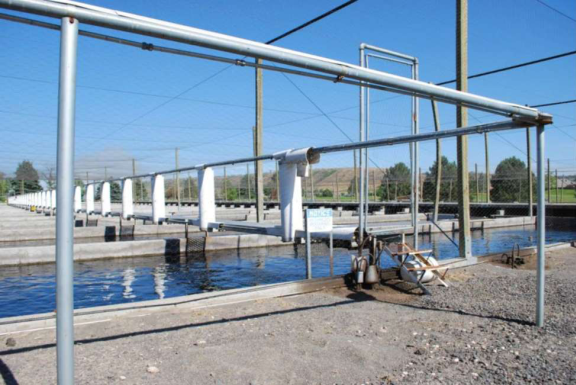
Other interventions intended to reduce muscle strains include keeping the fish tank loading dock at the same level as the fish hauling truck bed to avoid having to step up and down while carrying heavy loads; constructing fish hauling tanks to be waist high so that heavy loads of fish in a dip net do not have to be hoisted chest high; using metal chutes at the hauling tank discharge ports to allow for quick and easy stocking of fish; using dip nets attached to pulleys for easy manual lifting and a track for sliding (Figure 2); and using cranes and forklifts for all general lifting activities on the farm (Figure 3). The use of fish pumps and water pumps (Figures 4 and 5) prevents muscle strain (and saves time) because mechanized pumps move fish and water from place to place (Durborow, Myers, Cole, Semmens, & Thompson, 2011).
Figure 2.
Double Pulleys Above Dip Net to Reduce Load Weight by Half
and Allow Dip Net to Be Slid Down a Track
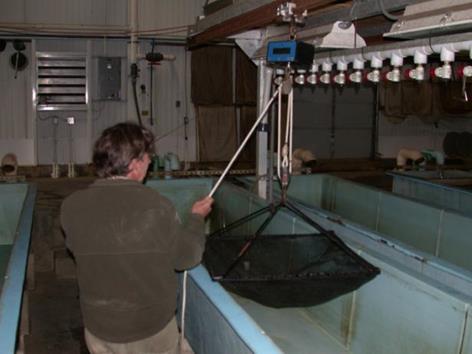
Figure 3.
Oxygenated Baitfish-Holding Vats Carried and Elevated by Forklifts to Load Hauling Truck
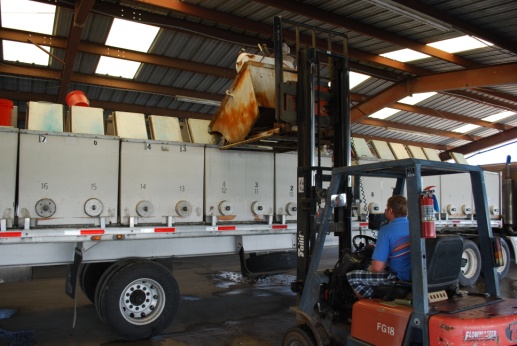
Figure 4.
Fish Pump Mounted on Back of Truck to Alleviate the Need to Use a Crane
to Lift Fish into Hauling Truck Tanks
Figure 5.
Overhead Water Supply to Allow for Easy Filling of Hauling Tanks
and Alleviate the Need to Manually Fill Tanks Bucket by Bucket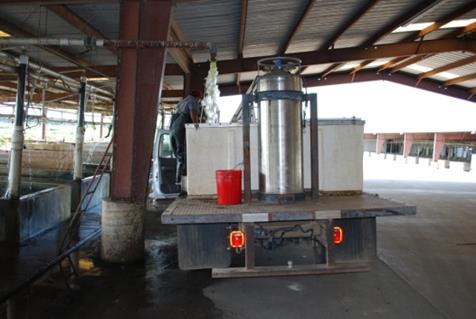
Fall Prevention
Settings with water, and possibly ice, are inherently hazardous with regard to potential slips, trips, and falls (and the obvious possibility of drowning after a fall). Walking on trout raceway crosswalks or on the narrow raceway walls themselves is risky, especially if the crosswalks are broken, rusty, or splayed or the raceway walls are crumbling or overly narrow. To reduce the risk of falling, one can install metal crosswalks that are in good condition and have traction/grip, or "grip-strut" (Figure 6), and widen raceway walls by widening the concrete or incorporating wide metal "grip-strut" attachments. Also, farmers can veneer wooden surfaces with rough, unfinished lumber or attach chicken wire to them (as is commonly done in the United Kingdom) to help ensure that such surfaces have sufficient traction even when wet (Durborow & Gomelsky, 2012). The extremely slippery surfaces that occur when smooth cement gets wet can be significant fall hazards (Myers & Durborow, 2012). Similarly, slips can occur when walking from a rough surface to a smooth surface and vice versa. To address these issues, one can use a coarse broom on newly poured cement so that the surface will have a rough texture when the cement dries (Figure 7).
Figure 6.
Traction-Providing "Teeth/Grips" on Grip-Strut Metal Walkway
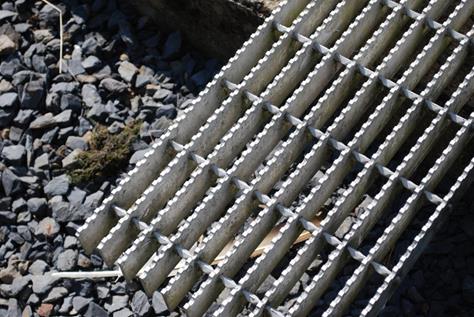
Figure 7.
Use of a Coarse Broom on Wet Concrete to Create Rough Surfaces
(for Traction) on Floors Around Fish Tanks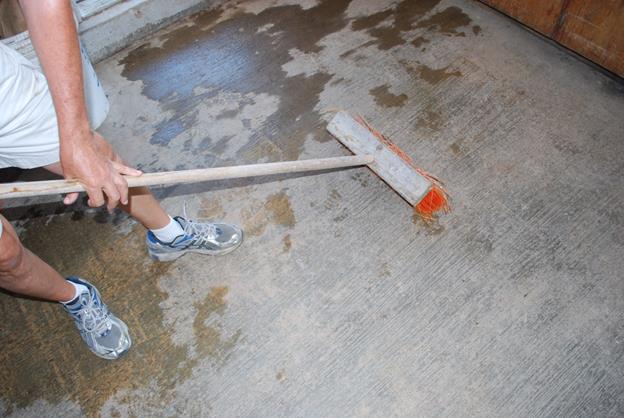
Aquaculturists can avoid falls from high places, such as the tops of feed bins, by implementing active safety measures, such as using enclosed metal guards that surround the metal ladder on the side of a feed bin (Figure 8). Active safety measures require one to play a role in one's own safety, such as by catching oneself on a metal guard to keep from falling.
Figure 8.
Guards on Feed Bin Ladders to Provide Active Protection
Against Falls for Workers Who Lose Their Footing
Like active safety measures, engineered safety interventions are important for reducing the risk of falls. For example, a cable attached to a feed bin lid that can be pulled from ground level to open the lid eliminates the need to climb to the top of the bin. An even better engineered intervention is a pipe that extends from the feed bin top to ground level, where a feed tanker truck can attach to it and blow feed into the top of the bin (Figure 9) (Myers, Durborow, & Cole, 2012). When climbing a ladder is necessary, one should wear a harness attached to a cable paralleling the ladder. Aquaculturists also should keep in mind situational scenarios that can increase the risk of falling. For example, usually when a worker is on the side platform of a hauling truck, a potential fall is only 3 or 4 ft; however, if the truck is parked on a ledge or steep levee, a fall could exceed 20 ft. To safeguard against such hazards, an Idaho trout farm has engineered retractable guard rails for the sides of hauling trucks (Figure 10). Under icy conditions (on hauling trucks or elsewhere on the farm), farmers can apply salt to melt ice or prevent it from forming. To increase traction on trucks, one Kentucky operation surfaced its trucks with SlipNOT high-traction metal plating ("pepper plate"), which is used on battleship decks (Ogunsanya, Durborow, Myers, Cole, & Thompson, 2011).
Figure 9.
Pipe Extending from Top of Feed Bin to Allow Feed Trucks to Fill Bin
from Ground Level and Alleviate the Need for Workers to Climb to the Top
Figure 10.
Grip Strut Walkway That Swings Down on Side of Hauling Truck
and Guard Rail That Slides Out to Provide Fall Prevention for Workers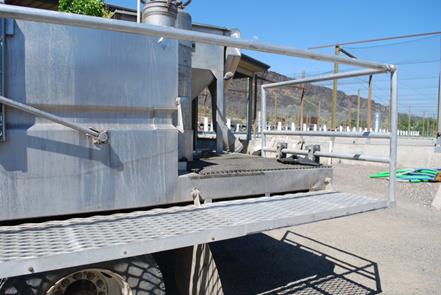
Conclusion
Extension personnel can use the aquaculture occupational safety information and photos presented here to help aquaculturists (and farmers, in general) become more aware of potential hazards and to provide ideas on how to avoid or eliminate such hazards.
Acknowledgments
Funding for the research reported here was from U.S. Department of Agriculture Capacity Building Grant 2007-38820-18506 and from National Institutes of Health Centers for Disease Control and Prevention (National Institute of Occupational Safety and Health, NIOSH) Cooperative Agreement number 2 U50 OH007547-07.
References
Burgus, S., Schwab, C., & Shelley, M. (2012). Assessing rural coalitions that address safety and health issues. Journal of Extension [online], 50(2). Article 2FEA7 Available at: http://www.joe.org/joe/2012april/a7.php
Byler, L., Kiernan, N. E., Steel, S., Neiner, P., & Murphy, D. J. (2013). Beginning farmers: Will they face up to safety and health hazards? Journal of Extension [online], 51(6). Article 6FEA10 Available at: http://www.joe.org/joe/2013december/a10.php
Durborow, R. M. (1997). Aquacultural hazards. In R. L. Langley, R. L. McLymore, Sr., W. J. Meggs, & G. T. Roberson (Eds.), Safety and health in agriculture, forestry and fisheries (pp. 659–679). Rockville, MD: Government Institutes.
Durborow, R. M. (1999). Health and safety concerns in fisheries and aquaculture. Occupational Medicine: State of the Art Reviews, 14, 373–406.
Durborow, R. M. & Gomelsky, B. (2012). British trout farms: Production and safety. Presented at: United States Trout Farmers Association Annual Meeting, September 6–8, 2012, Denver, Colorado.
Durborow, R. M., Myers, M. L., Cole, H. P., Hemstreet, W., Thomforde, H., & Semmens, K. (2011). Aquaculture Safety for Ponds. Lexington, KY: University of Kentucky.
Durborow, R. M., Myers, M. L., Cole, H. P., Semmens, K., & Thompson, S. (2011). Aquaculture safety for raceways. Lexington, KY: University of Kentucky College of Public Health.
Myers, M., & Durborow R. (2012). Aquacultural safety and health In E. Carvalho, G. David, & R. Silva (Eds.), Health and environment in aquaculture (pp. 385-400). Rijeka, Croatia: InTech. http://www.intechopen.com/books/health-and-environment-in-aquaculture
Myers, M. L., Durborow, R. M., & Cole, H. P. (2012). Inherently safer aquacultural work: Hierarchical hazard controls. Professional Safety; Journal of the American Society of Safety Engineers (July 2012) 57(7), 44–51.
Ogunsanya, T. O., Durborow, R. M., Myers, M. L., Cole, H. P., & Thompson, S. L. (2011). Safety on North Carolina and Kentucky trout farms: Avoiding work-related hazards. Journal of Agricultural Safety and Health, 17(1), 33–61.




